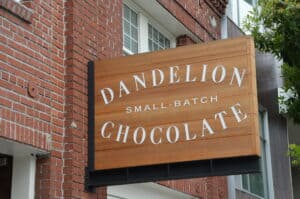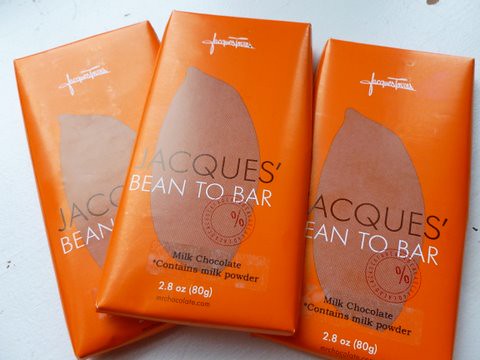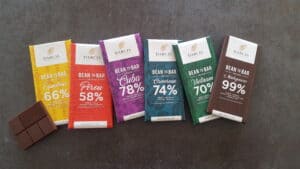The magic and allure of chocolate has fascinated many consumers for centuries. However, few are familiar with the term and concept of ‘Bean-to-Bar’ chocolate. This blog aims to demystify this term and delve deep into the chocolate-making process, highlighting the importance of this craft in producing high-quality chocolate.
Bean-To-Bar Chocolate
Bean-to-Bar’ chocolate refers to a process where chocolate makers control every step of chocolate production; from sourcing raw cacao beans to creating the final chocolate bar. Craft chocolate makers who embrace the bean-to-bar concept prioritize high-quality chocolate confections, focusing on taste and ethical considerations over mass production. This philosophy counters the typical large batch production seen in most chocolate factories owned by large companies, where the supply chain isn’t as transparent and quality can sometimes be compromised.
In the Bean-to-Bar world, the cacao bean is the star of the show. Thus, chocolate makers putting in the effort and time to source whole beans from countries such as Ecuador, Peru, or Madagascar, is quite common. Emphasizing single-origin chocolate bars, these makers often create distinct flavors in their bars that reflect the geographical location and fermentation process of their sourced beans.
The Bean-to-Bar Chocolate-Making Process

Sourcing the Beans
Ethics and quality drive the sourcing of cacao beans in the bean-to-bar process. Chocolate makers often engage with farmers directly to ensure fair trade practices. Some even visit the cacao farms to understand the farming practices, ensuring the cocoa beans are organic and ethically sourced.
Also, different beans, such as Criollo, Trinitario, and Forastero, offer varying taste profiles providing a wide canvass for chocolate makers to work with.
Roasting and grinding
Next, the raw cacao beans are roasted in small batches. The roasting time and temperature significantly impact the final flavor profile of the chocolate bars. Post-roasting, cacao nibs (the inside of the cacao beans) are ground, resulting in a paste-like ‘cocoa mass’ or chocolate liquor, which despite its name, contains no alcohol.
Conching
After grinding, the chocolate liquor undergoes a process known as ‘Conching,’ involving the heating and grinding of chocolate to refine the taste and texture. The length of the conching process again alters the chocolate’s taste, defining the flavor notes and ensuring a smoother texture by reducing the size of cocoa and sugar particles.
Aging, Tempering, and Molding
Once the chocolate liquor is conched, it’s usually left to age to enhance its flavors. Later, this aged chocolate is tempered by cooling and warming it repeatedly to ensure a shiny finish and a stunning snap when broken. Finally, the tempered chocolate is poured into molds to create the final chocolate bar. Additives like milk (creating milk chocolate) or nuts can be added during molding.
Why Choose Bean-To-Bar Chocolate?
The most notable reason to choose bean-to-bar chocolate is the unparalleled quality it brings. With chocolate makers in control of the whole process, the result is a flavorful, fine chocolate product that satiates even the most discerning palates.
With a growing demand for transparency in supply chains, bean-to-bar offers peace of mind. Every step, from sourcing to selling, is transparent. Many bean-to-bar makers also aim for their chocolate bars to be sustainable and ethically produced, adhering to fair trade practices, benefiting not just the farmers but also the environment.
Popular Bean-to-Bar Chocolate Brands

Several international chocolate award winners are renowned Bean-to-Bar chocolate makers. Brands like Dandelion, in San Francisco, or Askinosie in Kansas City, have made their marks globally, each having their own chocolate shops where customers can buy their products directly. Each offers chocolate bars of distinct single origins, reflecting the unique flavors from each location where the cacao beans were sourced.
How to Taste and Appreciate Bean-to-Bar Chocolate
Enjoying bean-to-bar chocolate involves all your senses. Look at its color, break it and hear the snap, smell the aroma, feel its texture, and lastly, savor the flavors as it melts in your mouth. What makes this experience even more enjoyable is comparing different chocolate bars. Try bars from various origins, cacao percentages, or by different bean-to-bar chocolate makers for an insightful hedonic escapade!
From Bean to Bar: Meeting the Key Components
Understanding Cocoa Butter, Cacao Butter, and Cocoa Powder
Cocoa butter, also known as cacao butter, is a vital ingredient in many chocolate bars. Extracted from the cocoa bean (or cacao bean), it lends chocolate its creamy texture and meltable quality. Half of cacao beans’ weight is cocoa butter, making it a significant part of a bar chocolate maker’s formula.
Cocoa powder, in contrast, is borne from the solids that are separated from the cocoa butter during the making process. It contributes the rich, chocolaty flavor in most chocolate drinks and baking chocolate.
The Variety: Dark Chocolate and Milk Chocolate Bars
The proportion of cocoa powder and cocoa butter also decides the type of chocolate- whether it’s dark chocolate or milk chocolate. Dark chocolate contains a high percentage of cocoa, usually over 70%, and less sugar, making it a favorite among chocolate aficionados for its intense flavor and less sweetness.
On the other hand, milk chocolate bars contain less cocoa and more sugar. They also have milk solids added, which gives them a smooth, creamy texture and sweeter, milder flavor compared to dark chocolate.
The Chocolate Maker & Mass-Produced Chocolates: The Difference
The role of a chocolate maker in the bean-to-bar process cannot be overstated. They control each step meticulously, from sourcing the beans to molding the final product.
In contrast, mass-produced chocolate usually involves large-scale operations where the primary emphasis may be on quantity rather than the quality you’ll find in bar chocolate maker’s products. The entire process may be automated, and ingredients may not be as carefully sourced or managed compared to a bean-to-bar process.
Incorporating Bean-to-Bar Chocolate in Baking and in Your Snacks

Baking chocolate is available in all types – dark, milk or even white chocolate. The high-quality chocolate from a reputable bar chocolate maker offers superior flavor to your baking. Bean-to-bar chocolate’s complex, robust flavors can significantly enhance cakes, cookies, or brownies. Make sure to pay attention to the type of chocolate a recipe calls for to ensure the taste is not affected.
Additionally, bean-to-bar chocolates also make for an exquisite afternoon or midnight snack for those moments when you need a little indulgence. With their rich flavors, these chocolate snacks provide a more pleasurable and satisfying nibble than regular, mass-produced chocolate.
Substituting your regular confectionery with bean-to-bar chocolate not only enhances your culinary creations but also supports an industry that preserves quality over quantity, and ethics over profit. Once you’ve discovered the diverse, rich, and ethereal world of bean-to-bar chocolate, your taste buds will surely thank you.
In conclusion, bean-to-bar chocolate transcends the usual concept of chocolate bars, combining quality, transparency, and ethics for a distinct chocolate experience. So, the next time you reach for a chocolate snack, choose bean-to-bar and relish the taste of artistry and dedication to this beloved sweet treat.

